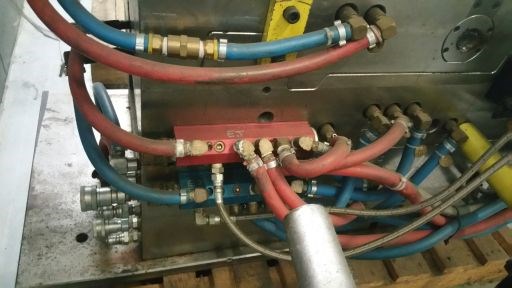The Designer’s Edge: Cooling Issues and Options
Randy discusses the ins and outs of water cooling options, including water manifold location, maintenance issues, flood systems and bubblers.

Some molders use manifolds on the molding machine versus on the tool. This eliminates the exterior water line hoses and keeps the tool cleaner for maintenance.
When it comes to cooling, some shops prefer water manifolds on the tool with one main connection for the in’s and outs to reduce setup time. However, a slight disadvantage with this option is the maintenance involved, as it requires the exterior water lines/hoses to be removed and protected. In most cases this is not a major ordeal, but some tools do have numerous lines and removing them and ensuring they are installed correctly adds extra labor. It is very important that connections are labeled to reduce the chances of cooling problems.
Another option for reducing connections is an internal flood system. This resides inside the tool and has one main in and out connection, eliminating any exterior hoses. Drawbacks include not being able to verify if a crossline has buildup or if it is restricted by all the lines being connected to the same feed line. To evaluate the lines you need to tear down the tool and remove all of the pipe plugs. With an external water manifold you could experience the same plugged line, but not be aware of it. However, you do have the ability to remove the hose or connection and verify each specific line for flow.
Some molders use manifolds on the molding machine versus on the tool. This eliminates the exterior water line hoses and keeps the tool cleaner for maintenance. This is my preferred option, as I’m the one responsible for tool maintenance. To reduce the number of connections you can hard plumb lines in a series. It is best to have these recessed in the side of the mold to protect them. Many shops just add loops with hoses, but this can increase setup time and risk of water issues if not looped correctly. A water diagram on the side of the mold can help to reduce this risk.
Bubblers are another option. They allow access to water in tight areas where the typical water line or baffle will not. Using high flow tubes instead of brass tubes is also recommended as they allow for more GPM. However, when using bubblers that are smaller than the water lines on the mold, it is critical to run these on their own circuit or you will restrict the flow of the other lines. Otherwise cooling will be reduced.









